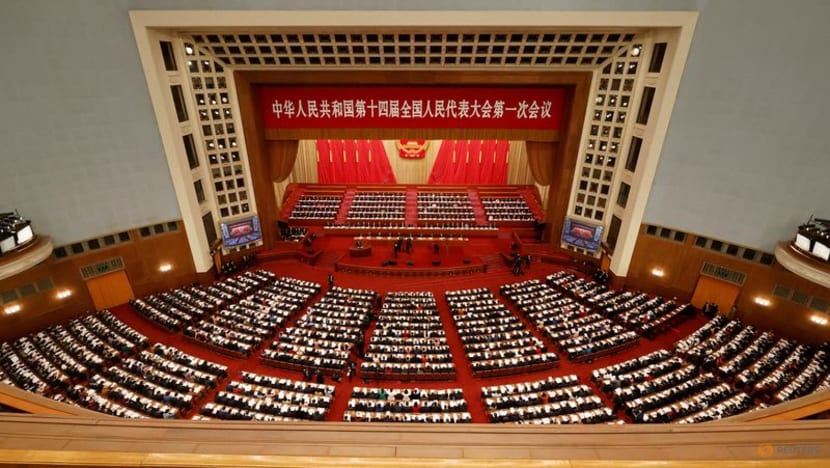Push for 'new productive forces' set to feature at China's upcoming 'two sessions'. What is it all about?
The concurrent annual meetings of the country's legislature and top political advisory body are to be held from next Monday (Mar 4). Key economic targets announced will reflect the government's confidence levels as external and domestic challenges bite.


This audio is generated by an AI tool.
SINGAPORE: A fresh push for productivity - or “new productive forces” as China calls it - is set to be a key theme at the country’s biggest annual political event next week, analysts believe, as Beijing works to ensure its modernisation goals stay on track amid geopolitical risks and an array of domestic challenges.
The upcoming "two sessions" will also serve as the first report card of sorts for Premier Li Qiang and other top leaders, a year after they were formally elevated to their posts.
At the same time, projecting confidence will be front and centre throughout the event, observers add, especially considering the added political significance this year with the country marking the 75th anniversary of the founding of the People’s Republic of China.
“The central government will try … to shore up confidence in the economy and dismiss the economic gloom and doom,” said Dr Lim Tai Wei, adjunct senior fellow at the National University of Singapore’s (NUS) East Asian Institute.
“It may be a morale-boosting session.”
UNDERSTANDING THE “TWO SESSIONS”
The two sessions or “liang hui” in Chinese are the concurrent annual meetings of China’s legislature, the National People’s Congress (NPC), and the country’s top political advisory body, the Chinese People’s Political Consultative Conference.
The latter’s meeting begins on Monday (Mar 4), with the NPC beginning its own a day later (Mar 5). They usually last between one and two weeks, and are held at the Great Hall of the People in Beijing with thousands of delegates in attendance.
A hallmark of the two sessions is the government work report, delivered by the premier at the opening of the NPC. It charts the course of the world’s second-largest economy, setting out economic and policy goals for the year ahead.
These include targets for key indicators such as gross domestic product (GDP) growth and fiscal deficit. Projected defence spending is also presented during the NPC meeting.
It will be Premier Li Qiang’s maiden work report, after he was formally appointed China’s No 2 official last March.
Observers told CNA the report will run the gamut of topics - be it the economy, national security or party discipline - and isn’t expected to rock the boat.
“A lot of the things which will be mentioned, a lot of the themes, there'll be more continuity than changes,” said Dr Hoo Tiang Boon, associate professor at the School of Social Sciences at Singapore’s Nanyang Technological University (NTU).
EYES ON THE ECONOMY
Close attention will be paid to the figures released during the two sessions - particularly the GDP growth target, as it is a barometer of China’s economic confidence amid tensions with the West and an uneven domestic recovery.
At last year’s event, China announced its lowest GDP growth target in three decades - around 5 per cent - even as the country left behind its strict and costly zero-COVID policy.
While the final figure for 2023 came in at 5.2 per cent, meeting the official target, slower economic growth is expected to persist in the coming years as forecast by the International Monetary Fund (IMF), which cited “headwinds from weak productivity and population ageing”.
Other issues include the property downturn, local government debt and heightened youth unemployment.
Also in the mix - external hurdles such as tensions with the West.
The US has imposed export controls on high-end semiconductors and chipmaking tools to China. Washington has also lobbied allies with key suppliers to adopt similar curbs.
As the challenges stack up, the two sessions could provide indications of potential government action to come.
“Many are looking forward to stimulus packages for the economy. Reinvigoration of post-COVID recovery will be given importance,” NUS’ Dr Lim told CNA.
Still, another observer does not expect the economy to be singled out for special mention.
“If you focus too much on it to the detriment of other areas, it basically sends a signal that maybe the central authorities recognise that there are indeed problems in the economy,” said Dr Hoo.
“I don't think they would want to overhype all these risks because by doing so it's sending negative market sentiment.”
DEVELOPING "NEW PRODUCTIVE FORCES"
Either way, analysts expect a fresh push for productivity and innovation to be made at the two sessions amid the economic troubles.
Specifically, the development of “new productive forces” or “xin zhi sheng chan li” in Chinese, which state media have termed “a recent catchphrase in China’s policy-making”.
The phrase was first mentioned by Chinese President Xi Jinping in September last year, during an inspection and research trip in Northeast China.
“It basically means new industries to drive China's development … like high-end semiconductors, AI, big data, the next Internet,” Dr Hoo told CNA.
He linked it to China’s pursuit of self-reliance and high-quality development, pointing out how this can be seen as a response to external trends such as decoupling - or de-risking as it’s known in Western parlance.
Official data showed that annual foreign investment flows into China shrank for the first time in over a decade last year. Overseas companies invested 1.13 trillion yuan (US$157.1 billion) in China in 2023, an 8 per cent drop on-year.
The value of announced US and European greenfield investment into China dropped to less than US$20 billion in 2022, from a peak of US$120 billion in 2018, according to US-based research firm Rhodium Group.
Clarity on “new productive forces” could be offered at China’s third plenum, observers believe. The third plenum is an economy-focused gathering of the Chinese Communist Party’s Central Committee.
The event has been delayed from last year and a formal date has not been set. There have been recent reports suggesting the groundwork is being laid for it to be staged soon.
That being said, the core ideas of “new productive forces” - leveraging science and technological innovation, and generating new industries - are mainly a rebranding and “not anything groundbreaking”, Dr Hoo said.
“(It’s) to drive the next stage of China’s modernisation, which they see as under some challenge, principally because of the measures being imposed by the US and the West,” he added.
PROMOTING A PRODUCTIVE POPULATION
Demographic challenges are also a factor behind the national productivity drive, experts noted. China’s population fell for a second straight year to 1.41 billion in 2023.
The fresh data has fanned concerns that growth prospects are diminishing due to fewer workers and consumers, while the rising costs of elderly care and retirement benefits put more strain on indebted local governments.
China is already beginning to feel the impact of an ageing population on areas like the economy, healthcare, national security and competitiveness, said NUS’ Dr Lim.
The population decline is an indication of China’s success in modernisation and in development, according to NTU’s Dr Hoo, who said it is a common problem faced by most developed countries.
China’s East Asian neighbours - South Korea and Japan - are also contending with the same issue, for example.
“A lot of scholars worry, even internally within China, that before China becomes rich, it will grow old,” Dr Hoo told CNA.
“In order for China to continue to have sustainable economic growth, it certainly has to look for ways to increase its productivity, even though it is doing so with a population with declining growth trends.
“This probably links to this new narrative of new productive forces.”
MARKING A "MILESTONE" YEAR
There’s added political significance to the two sessions this year, coinciding with the 75th founding anniversary of the People’s Republic of China (PRC).
That’s three-quarters of the way to the PRC’s centenary in 2049. The Chinese Communist Party (CCP) has set the goal of building a “modern socialist country that is prosperous, strong, democratic, culturally advanced and harmonious” by then.
Considering this “milestone” year, the government work report delivered during the two sessions will “certainly” project confidence in China’s development, future and overall economic trajectory, said Dr Hoo.
In terms of the economy, China is aiming to be “dominant” and self-reliant by 2049, Dr Lim from NUS told CNA, noting that China has already been the world’s largest economy by purchasing power parity since 2017.
On the military front, the CCP is striving to build a world-class military “capable of fighting and winning wars”, he added.
As for being culturally advanced and harmonious, Dr Lim noted that this was the “most amorphous”.
“It may refer to soft power, the ability to convince others to follow its need without the need to use force,” he added.
NTU’s Dr Hoo, though, has a different take on China’s PRC centenary targets, pointing out the lack of concrete indicators.
“The 2049 goal is essentially more of a political narrative as opposed to a target per se,” he told CNA.
“Put it this way - China, if it wants, could arguably say that it has already become a modern socialist country,” he added.
“I'm pretty sure that by 2049, they will declare that they have met their targets.
“The real goal (is) to sell that political story, of the CCP’s achievement and success - to say that China has become strong, in particular under Xi Jinping. And they have achieved the great rejuvenation of the Chinese nation.”



















